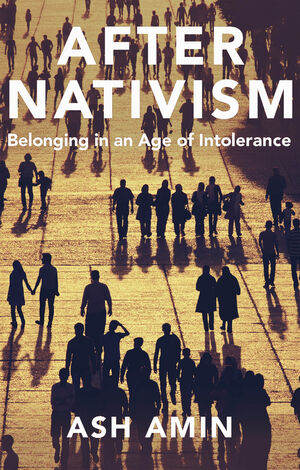The appeal of nativist politics and what comes next

Published by: Polity

Ash Amin’s After Nativism is another work in the line of recent scholarly contributions to tackling the rise of the nativist far right. Amin, an Emeritus Professor of Geography at the University of Cambridge, responds to the timely challenge by addressing what he sees as the mobilization appeal of nativist politics. The result is a passionate, richly argued, inspiring book, but also one that is often more convincing in its diagnoses than in the solutions it proposes.
Amin sees nativism’s success in its “affective force as a story of national belonging and becoming, strengthened by the absence of a similarly persuasive counter-narrative” (p. 160). Nationalism’s appeal is in making one feel a part of something bigger, more meaningful than ourselves. How can progressives reclaim this feeling from the ethnonationalist, exclusionary framing that emphasizes the fear of the “Other”, be they minorities, immigrants or refugees? The answer: by developing a new narrative and aesthetics of belonging. Ensuring material security is not enough to defeat the politics of nativism; progressives need to offer an alternative “political imaginary of belonging” (p. 4) capturing existing societal pluralities and “practices of living together” (p. 30). And to communicate this imaginary, additional steps are necessary: reinforcing the public sphere by regulating hateful speech and reforming social media as places of “centrifugal animosities” (p. 5); reforming expert communication to reduce claims of its elitist bend; and creating a new communicative aesthetic based on capturing the identified “archive of affirmative practices of coexistence” (p. 6) to challenge the familiar aesthetics of nativist nationalism.
“The Intimate Public Sphere” describes what Amin sees as a public sphere of smaller, intimate publics, both participatory and dominated by intermediaries, algorithm-fueled conflict and polarization—which requires new forms of progressive engagement.
Following the Introduction which lays out the key ideas, the book is structured into four chapters. “Grounds of Belonging” offers a deliberately broad-brush overview of the current nativist wave, identifying not economic anxiety but cultural, identity grievances as the core of nativist narrative that needs to be addressed. It also demonstrates how, beyond the nativists’ sketch of a native community and the impossible-to-integrate “Others”, ethnographic work reveals a very different picture of “relationally constituted” (p. 32) communities of individuals with complex, multiple identities establishing ties with each other and their shared spaces, despite—or alongside—racial and other prejudice and mutual skepticism. “Street Affinities” closely observes these dynamics amongst residents of two poor urban settlements in New Delhi. “The Intimate Public Sphere” describes what Amin sees as a public sphere of smaller, intimate publics, both participatory and dominated by intermediaries, algorithm-fueled conflict and polarization—which requires new forms of progressive engagement. The chapter makes a case for social media regulation and the social co-construction of knowledge to restore public trust in expertise. Finally, “Aesthetics of Nation” proposes moving away from both romantic and civic tales of nation reliant on pinpointing “inherent national characteristics” (p. 141) and towards arts that present the narrative of everyday coexistence identified earlier.
I agree with Amin that captivating narratives largely drive nativist support, and his analysis of the “dynamics of cohabitation” (p. 52) amongst the poor is rich and engaging. But I am not convinced that simply telling these stories will overwrite the nativist narrative, as its broad-brush argument is not necessarily that micro-level coexistence is always impossible, but that removing “‘Others” would create more resources for “us” (e.g. current requests in Ireland to “house our own” rather than the “unvetted” asylum seekers). Nativism is (also) a framing of interest: the immigrant is dangerous because he or she is a threat to someone’s livelihood, culture, safety or other desirables. This threat does not need to be, and often is not, real. It is based on uncritically accepted disinformation, nostalgic, subjective (e.g. a perceived loss of status), or projecting on other, imagined co-nationals (the unprotected women, the imagined workers losing jobs to “illegals”); hence support for the AfD in Germany is not predicated on income/class but on attitudes towards immigrants (Arzheimer and Berning, 2019), and the largest employment group among the January 6th insurrectionists in the US were white collar (43%), not blue (Chicago Project on Security Threats, 2022). Citizens have the world and their interests framed by nativists in a certain way; simply being exposed to narratives of coexistence doesn’t address this. Highlighting the experiences of coexistence should, however, be utilized more by non-nativist governments and politicians (and media!), but in a particular way. We’ve known at least since Allport’s 1954, The Nature of Prejudice that working towards a common goal encouraged by power-holders makes diverse groups less antagonistic; newer research indicates that even knowledge of such contact can be effective (see Christ and Kauff, 2019); and a prosperous, safe society for all can be broadly seen as such a shared goal.
I am also skeptical that existing networks of interconnectedness alone can be the grounding for identity: ties of solidarity are important, but not the same as those of (political) self-identification. This difference is potentially visible (open to interpretation) in Desmond and Travis’ (2018) ethnographic and large-N work on the urban poor in Milwaukee, which demonstrates how residents of low-income neighborhoods develop support systems (like in Delhi) but not political capacity, as they see themselves “in but not of a community” (p. 874), and the setting—and knowledge residents have of each other’s difficulties—fosters “sentiments of disempowerment” (p. 476) rather than political action. In other words, poor residents hope to “do politics” somewhere else, with someone else. Mutual ties don’t necessarily trump dislike or exclusion of the “Other”, but perhaps just set it aside due to necessity.
at a time when the media often platform random individuals with opinions as equal to experts and claims to (non-expert) knowledge are frequently disingenuous, treating all forms of knowledge as potentially valid could be part of the problem rather than a solution for rampant misinformation.
The second part of the book offers interesting ideas but could use further development. It is, considering things like targeted advertising on Facebook during the Brexit campaign and its contribution to misinformation, not difficult to agree that some form of ethical regulation of online platforms is needed; but how this should be done is not obvious. Moreover, it is not just social media, but traditional media that aid exclusionary politics by giving space to nativists and their issue framings, yet this remains entirely unaddressed. And while knowledge co-construction as a method of trust-building is interesting, it made me wonder about the conditions and boundaries of such action: at a time when the media often platform random individuals with opinions as equal to experts and claims to (non-expert) knowledge are frequently disingenuous, treating all forms of knowledge as potentially valid could be part of the problem rather than a solution for rampant misinformation. What happens when “second nature knowledge” (p. 129) and scientific knowledge radically collide in an atmosphere of conflict fueled by malicious interests?
Finally, while Amin is right about art’s capacity for creating and sustaining the national imaginary, the issue seems to me to be both the absence of works promoting the cohabitation narrative and the absence of viewership. I am thinking here primarily of film, the medium I am most familiar with, and in which well-meaning, progressive depictions of coexistence even by prominent authors like the Dardenne brothers in Belgium hardly reach viewers beyond the art-film circle, due to complex reasons encompassing media literacy, European film funding and distribution policies, and the creative sensibilities of the directors. There may be a need for a “minor aesthetics of belonging” (p. 150), but how to ensure that it reaches its audience and communicates with them? Amin is likely not unaware of this challenge, but seemingly more optimistic than myself regarding its relevance.
Tamara Kolarić is an Assistant Professor in Social Sciences at the School of Applied Language and Intercultural Studies, Dublin City University. Her research interests include memory politics, cinema, and the intersections of the two in all forms in the post-Yugoslav context and beyond.
